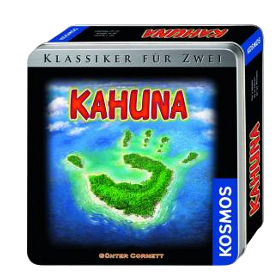Kahuna
 Kahuna ทั้งสอง ผู้วิเศษแห่งทะเลแปซิฟิก ต้องค้นหาว่าใครคือผู้ทรงอำนาจที่สุด
Kahuna ทั้งสอง ผู้วิเศษแห่งทะเลแปซิฟิก ต้องค้นหาว่าใครคือผู้ทรงอำนาจที่สุด
ทั้งสองต้องแข่งกันเพื่อครอบครองหมู่เกาะทั้งสิบสองเกาะนี้ให้ได้มากที่สุด
ผู้เล่นทั้งสองสร้างสะพานระหว่างหมู่เกาะในทะเลใต้
เมื่อผู้เล่นสร้างสะพานที่เชื่อมต่อกับเกาะเป็นจำนวนมากกว่าคู่ต่อสู้ ให้ผู้เล่นวางเหรียญ Kahuna ไว้บนเกาะนั้น
หลังจากนับคะแนนครบทั้งสามรอบแล้ว ถ้าคุณมีคะแนนมากกว่าคู่ต่อสู้ คุณจะกลายเป็นผู้ครอบครองอาณาจักรแห่งเกาะนี้และเป็นผู้ชนะเกม
จำนวนผู้เล่น: 2
ระยะเวลาของเกม: 22 mn
ความซับซ้อน: 2 / 5
เล่น Kahuna และ 1194 เกมอื่นๆ ออนไลน์
ไม่จำเป็นต้องดาวน์โหลด - เล่นได้โดยตรงจากเว็บเบราว์เซอร์ของคุณ
กับเพื่อนและผู้เล่นนับพันจากทั่วโลก
ฟรี.

เล่น Kahuna และ 1194 เกมอื่นๆ ออนไลน์
ไม่จำเป็นต้องดาวน์โหลด - เล่นได้โดยตรงจากเว็บเบราว์เซอร์ของคุณ
กับเพื่อนและผู้เล่นนับพันจากทั่วโลก
ฟรี.

กฎย่อ
Summary:
Players use cards to place bridges between islands or remove opponent's bridges. If you get the majority of bridges around an island, you place one of your marker stones on it and also remove any of your opponent's bridges to that island – which might cause them to lose a bridge majority on an adjacent island and lose a marker stone there.
The game is played in three rounds. A round ends when all cards from the face down deck and the three face up cards have been taken. Then points are scored for the player with the most marker stones on the board. The game can also end sooner when one player has absolutely NO bridges left on the board.
Playing the game:
During a turn a player may play from 0-5 island cards. After playing all the island cards desired, the player draws one card to add to his hand. A player may never have more than 5 cards in his hand.
Playing island cards
• When a player plays a single card, he discards it and then places a bridge on one of the available dotted connecting lines between the island on the card and one of its neighbors.
• If the player wants to play several cards, they are played and bridges placed one at a time. (exception: removal of opponent’s bridge)
• Instead of playing card(s), a player may discard one or more cards secretly under the discard pile.
• A player may choose to play no cards in a turn.
Control of an island: marker stone placement
• When a player has bridges on more than half of the connecting lines from an island, he controls that island and places one of his marker stones on the island. Note: the cards indicate the number of connecting lines an island has under its name.
• When a player gains control of an island, he removes any bridges on that island belonging to his opponent. If such a removal causes the loss of control on a neighboring island, the marker stone on the effected island is also removed.
Removal of opponent’s bridge
A player may play a pair of island cards to remove an opponent’s bridge between two islands. The two cards must name only the two islands connected by the bridge to be removed.
For example, the bridge connecting HUNA and ELAI can be removed only by playing one of the three following pairs of cards: "HUNA - ELAI", "HUNA - HUNA", or "ELAI - ELAI". The player could then play a card from either island (for example: HUNA or ELAI) to place his bridge between the two islands.
Drawing an island card
After a player has played all cards he desires, he may add one card to his hand, taking either one of the three face-up cards or the top card from the face-down stack. When one of the three face-up cards is taken, it is replaced by the top card from the face-down stack. However, if a player chooses not to take a card, his opponent must take a card on his next turn.
If a player has five cards in his hand and chooses to take a card, he must first discard one or more cards.
A player’s turn ends when he takes a card or indicates he has chosen not to take a card.
Scoring, Rounds 1 & 2:
When the last card is taken (from the face-down stack and the three face-up cards) in the first and second rounds, the number of marker stones each player has on the board are tallied.
If the players control the same number of islands at the end of a round, no points are scored.
After the first round, the player with the most islands scores 1 point.
After the second round, the player with the most islands scores 2 points.
After scoring, the discard pile is shuffled and three cards are placed face-up. Play continues with the player who was next to play when the last card was taken.
Final Scoring and Game End:
When the last card from the face-down deck is taken at the end of the third round and the last of the face up cards has been taken, each player takes one additional turn (without taking cards). After those two turns, the islands are scored for the third and final time. This time the player with the most islands is awarded the difference in points. These points are added to those previously earned.
The player with the most total points from the three rounds is the winner.
If there is a tie, the player who scored most in the third round is the winner.
If there is still a tie, the player with the most bridges at the end is the winner.
The game can also be ended at any time during the second or third round if one player has no bridges on the board. If this happens, the other player is the winner.

